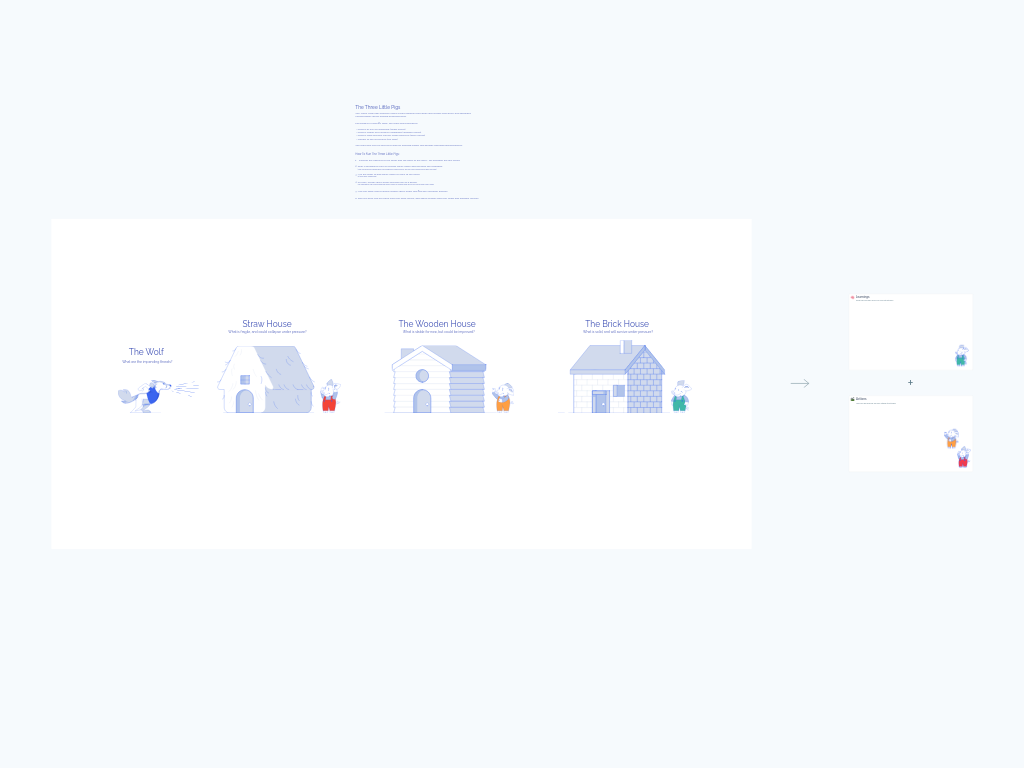Three Little Pigs Retrospective
The Three Little Pigs retrospective template uses the classic children's story as a powerful framework for identifying and categorizing the strength of your team's processes, tools, or practices. By examining what's fragile, what's stable but improvable, and what's rock-solid, teams can prioritize improvements and protect against potential threats.
What Is the Three Little Pigs Retrospective?
This retrospective format leverages the familiar fairy tale metaphor to help teams evaluate the robustness of various elements in their work environment. Just as the three little pigs built houses of different strengths, your team will classify aspects of your work into three categories:
- Straw House: Fragile elements that could collapse under pressure
- Wooden House: Stable components that work but could be upgraded
- Brick House: Solid structures that will withstand challenges
The template also includes a fourth element—The Wolf—representing external threats or pressures that might test the durability of your processes, tools, or practices.
Benefits & When to Use
This retrospective is particularly effective when:
- You need to assess the resilience of your processes, infrastructure, or team practices
- Your team has weathered recent challenges and wants to identify vulnerabilities
- You're preparing for potential future challenges (product launches, organizational changes)
- You want a fresh approach to discussing technical debt or process improvements
Teams benefit from this format because it:
- Creates a non-confrontational way to discuss weaknesses
- Provides a clear categorization system for improvement priorities
- Incorporates risk assessment through the Wolf component
- Balances problem identification with appreciation of strengths
How to Run a Three Little Pigs Retrospective Session
Introduction (5 minutes)
- Present the exercise to the team and explain the topic of focus (last sprint, specific project, team processes)
- Explain the metaphor and what each house represents
Setup (2 minutes)
- Start a Meeting to become the facilitator, enable private sticky notes, and control available tools
- This prevents participants from editing the board layout while allowing focused participation
Brainstorming (10 minutes)
- Ask team members to add sticky notes to each area:
- Straw House: What's fragile and could collapse under pressure?
- Wooden House: What's stable for now but could be improved?
- Brick House: What's solid and will survive under pressure?
- The Wolf: What are the impending threats to our work?
- Ask team members to add sticky notes to each area:
Sharing & Discussion (15 minutes)
- In turns, team members reveal their sticky notes
- Discuss each contribution, asking clarifying questions
- Tip: Participants can reveal individual sticky notes by clicking the disc at the top of each note
Grouping & Themes (10 minutes)
- Use the Topic tool to group similar sticky notes
- Identify common themes emerging from each house
- Vote on priority items if needed
Action Planning (15 minutes)
- Discuss what can be learned from the brick house—what makes these elements strong?
- Agree on actions to strengthen the straw and wooden houses
- Consider how to mitigate the threats identified in the wolf section
- Document specific, actionable next steps with owners and deadlines
Tips for a Successful Session
- Focus the scope: Be clear about what aspect of work you're evaluating (code quality, team processes, specific features)
- Balance attention: Don't spend all your time on weaknesses; learn from strengths too
- Consider urgency: Use the Wolf section to prioritize improvements based on actual risk
- Time-box discussions: The template suggests a 10-minute timer for brainstorming; keep other sections moving too
- Connect to action: Always end with clear, assigned action items to strengthen the straw and wooden houses
- Encourage honesty: Create psychological safety so team members feel comfortable identifying weaknesses
- Follow up: Revisit the actions in subsequent meetings to track progress
By structuring your retrospective around this fairy tale metaphor, you create a memorable and effective framework for continuous improvement that resonates with team members and drives meaningful change.



